Published Rizzoli International Publications, Inc. 1990
These essays have been edited from their published versions
CHAPTER 4 - Hitler ::
Alan Balfour » skip to photos
The spiraling instability undermining the culture was fueled at the extremes by the continuing conflict between the Liberals and their romance with the millennium, and the fundamental conservatism of the Nationalists. One believing only in the future, the other seeing only the past, and the socialists and capitalists would look both ways.
Hitler the architect: Between the eighth and ninth of November 1923 a small group from the National Socialist German Workers' Party attempted to seize the government of Bavaria. They declared a new republic under the presidency of Adolf Hitler. The Beer Hall Putsch proved to be a fiasco and was quickly put down by the militia. In February of 1924 Hitler was put on trial for high treason. The motives of the conspirators found sympathy with the judiciary, and Hitler served only nine months of a five years sentence in the Landsberg Fortress. In detention, with the help of prison colleagues, he dictated the first volume of his political philosophy, Mein Kampf (My Struggle). The forces of material-ism corrupting the city were vividly in his mind:
"Yet, how truly deplorable the relationship between state buildings and private buildings has become today! If the fate of Rome should strike Berlin, future generations would someday admire the department stores of a few Jews as the mightiest work of our era and the hotels of a few corporations as the characteristic expression of the culture of our times...
Thus our cities of the present lack the outstanding symbol of national community, which we must therefore not be surprised to find, sees no symbol of itself in the cities. The inevitable result is a desolation whose practical effect is the total indifference of the big city dweller to the destiny of his city. This too is a sign of our declining culture and our general collapse. The epoch is stifling in the pettiest utilitarianism, or better expressed, in the service of money."
As he wrote of the chaotic condition of the German culture and argued for lebensraum (living space) for the German peoples in the East, not just words but images filled his mind, images of the great buildings that would be the fruits of the mission that lay ahead. Hitler's new order is darkly shaded. Around the octagon Hitler's Reich Chancellery is to the North. On the west Columbus Haus is embedded in the new order. To the southwest, where the road from Potsdam crosses the great axis where the traveler crossed the stream in 1737, will be created a vast round plaza. The round peninsula of Haus Vaterland survives intact to the south. He made two drawings - One of a domed hall, the other of a triumphal arch - which were to remain with him till the last hours of his life. It seems that they almost drew themselves; such was the ease and confidence with which the architecture is described. They made the political project concrete. They set the stage for the future. The Hall would be at the center of the new political order; the Arch would pay tribute to the victims of the struggle by which the new order would be established. Their style was imperial; their scale, as judged by the ant-like creatures marching towards their base, astounding; their place was to be the center of Berlin. Years later Hitler was to share these two drawings with the architect Albert Speer.
Throughout his life Hitler preserved the feeling of being the architect "manque." In Mein Kampf he wrote, that in the years 1909 and 1910 "I painted to make a living and studied architecture for plea-sure...[and] my faith grew that my beautiful dream for the future would become reality after all, even though this might require long years. I was firmly convinced that I should someday make a name for myself as an architect." He applied but was denied admission to the Vienna Academy. The problem was not lack of skill, but inadequate high school preparation. Yet fate could have interceded in other ways, as Speer observed much later: if before the Great War of 1914-1918, instead of drawing city views for picture postcards, Hitler had been offered even a modest building commission the history of the world could have been profoundly different.
Hitler used strong used metaphor and idea construction on his writing. He vividly represents in words the physical order underlying the character of his global project. The style of its architecture would by necessity be classical, not only for heroic form, but because the Greeks and the Germans were racially linked:
"It is ... no wonder that each politically heroic age in its art immediately seeks bridges to a not less heroic past. The Greeks and the Romans suddenly become very near, because all their roots lie in a founding race, and therefore, the immortal accomplishments of the ancient peo-ples have an attractive influence on their racially related descendants.
Therefore, since it is better to imitate something good than to produce something new but bad, the surviving intuitive creations of these peoples can today doubtless fulfill their educative and leading mission through style.\0xD3
It would be classical also because the Roman ideal had been destroyed by Jews and Christians and their degrading promotion of equality under the worship of a single God:
"It's since St. Paul's time that the Jews have manifested themselves as a religious community, for until then they were only a racial community. St. Paul was the first man to take account of the possible advantages of using a religion as a means of propaganda.
If the Jew has succeeded in destroying the Roman Empire, that's because St. Paul transformed a local movement of Aryan opposition to Jewry into a supra-temporal religion, which postu-lates the equality of all men amongst themselves and their obedience only to God. This is what caused the death of the Roman Empire."
Only Imperial Rome had opposed the multiple corruption of Jewish Christian Bolshevism:
"Christianity is a prototype of Bolshevism: the mobilization by the Jew of the masses of slaves with the object of undermining society. Thus one understands that the healthy elements of the Roman world were proof against this doctrine."
Not only imperial and racist, but also absolutely conservative because the lessons of history showed that:
"A very large measure of individual liberty is not necessarily the sign of a high degree of civilization. On the contrary, it is the limitation of this liberty within the framework of an organization which incorporates men of the same race, which is the real pointer to the degree of civilization attained."
Explicitly from the texts Hitler saw himself as the recreator of the material world; an architect demiurge called upon by the forces of history and culture to undertake the salvation of Western civilization.
Among the 1924 notes for Mein Kampf he wrote:
"Parliamentarianism as vocation and trade Salvation through Parliament impossible changing the foundations the programme of a new movement - the D. A. P. minority not majority makes world history Not the majority will save Germany Not the dictatorship of the Jews but the dictatorship of genius See Rome Today we take our stand as apostles We aim to build a new age And hope, that whoever now declares I must make a clean break will also declare I am a German.\0xD3
"The dictatorship of genius" was precisely how he saw his project. It echoes the Nietzsche call in the "Will to Power" for the "Lords of the Earth:"
"-A new vast aristocracy based upon the most severe self discipline, in which the will of philo-sophical men of power and artist tyrants will be stamped upon thousands of years: a higher species of man which, thanks to their preponderance of will, knowledge, riches, and influence, will avail themselves of democratic Europe as the most suitable and supple instrument they can have for taking the fate of the earth into their own hands, and working as artists upon man himself. Enough! The time is coming for us to transform all our views on politics.\0xD3
The idea of shaping humanity occurs frequently in 19th century German texts. Schiller wrote that when an artist sets his hand to material he:
"... has no qualms about doing violence to it; he merely avoids displaying that violence. He will however seek to deceive any defender of the freedom of the material by pretending to respect it.
It is a quite different matter with the pedagogical and political artist, who uses human beings both as his raw material and as his project. Here purpose returns to the material, and only because the whole serves the parts may the parts lend themselves to the whole.
Thus the artist of the state must have a quite different respect for his materials than the sculptor pretends to have for his. He must protect the peculiarity and personality of his material, not subjectively, in order to produce a deceiving effect in the senses, but objectively for its true inner self.\0xD3
This echoes Goethe in calling for the artist of the state to protect the personality of the material to reveal its - \0xD2true inner self\0xD3 whereas Hitler would reform the state with the procrustean imposition of imperial order unconcerned with its natural character. "Politics, too, is an art,\0xD3 wrote Joseph Goebbels , Nazi Minister of Propaganda, in 1933, "Perhaps the highest and most far reaching one of all, and we who shape modern German politics feel ourselves to be artistic people, entrusted with the great responsibility of forming out of the raw material of the masses a solid, well wrought structure of a volk."
Architect as demiurge, or demiurge as architect, Hitler's actions can all be seen as aspects of artistic construction. He placed himself conceptually, first as architect of the reconstruction of the German people then as architect as recreator of the world. The killing of what he considered undesirable was a decision physically equivalent to the demolition of useless or dangerous structures. His armies moving into battle were in his imagination as construction crews setting forth to lay the foundation for an eternal future. The laying in waste of great cities was an effective by-product, cleansing reality of regressive memory. His great project would end instability and speculation in the culture of the state; it would end the progressive waste of time; it would establish an eternal past against which all future actions could be measured. "In the midst of peace time," Speer wrote after the War, "while continually proclaiming his desire for international reconciliation [Hitler] was planning buildings expressive of an imperial glory which could be won only by war." They were wars waged for empire, but beyond empire lay the true object of Hitler's desire to be the architect of the permanent reestablishment of Western reality - to be the savior of Western Man.
The two drawings from the Landsberg Fortress made in the midst of an intensity of visions reveal the desire of an architect. They are windows into the soul. "I never doubted,\0xD3 Hitler told Speer, "that someday I would build those two edifices."
The Chancellery
On
January 30,1933, German President Paul von Hindenburg appointed Hitler
Chancellor, and Hitler moved into the old Chancellery north behind
Leipziger Platz on Voss Strasse. On June 30,1934, Hitler purged all
rivals both in the Party and in the state. On the death of Hindenburg
on August 2, 1934, Hitler proclaimed himself head of state. Eva Braun,
Hitler's mistress, wrote in her diary on February 15, 1935: "Berlin seems to be on the cards at last. But until I'm in the Chancellery I shan't believe it. Let's hope it's going to be fun."
Then on the 28th of May 1935 she wrote:
"Dear Lord, I am afraid he won't answer today. If only someone would help me, everything is so terrible and hopeless.
Perhaps my letter reached him at the wrong moment. Perhaps I oughtn't to have written at all. Whatever happens uncertainty is more unbearable than a sudden end.
Dear Lord help me, let me speak to him this day, tomorrow will be too late.
I have decided on 35 pills, this time I want to make 'dead certain.' If only he would ring me-\0xD2.
In January of 1938, Hitler commissioned the architect Albert Speer to deign a new Reich Chancellery. The commission was for extension of the existing chancellery, which had housed the chief minister of the state since the 19th century, and by Hitler's decree all aspects of the new construction had to be completed within one year. Speer ordered demolition on the site within hours of receiving the commission, and quickly established the reputation as a brilliant manager. Four thousand five hundred workers of all trades labored on the site two shifts every day throughout the year, and many thousands more throughout the nation worked with equal intensity to produce the furnishings and decorations.
It was a mature design for the 34-year-old Speer. The land north of Voss Strasse had, since the 18th century, been occupied, first by the large palaces of the urban aristocracy, and subsequently by the many branches Prussian state government. Speer's plan gave unity not only to Voss Strasse, but also created a formal garden and garden facade. The central range of offices linked the two main wings in an order of restrained classicism; the western end faced Columbus Haus. Neue Reichskanzlei on Voss Strasse 1939. The windows in the foreground look across to Potsdamer Platz and Columbus Haus. The wings were dominated by the brutally powerful portals, showing a clear debt to Hitler's first architect Paul Troost. Their thin classical form carrying the great rising eagle has come to be seen as the quintessen-tial expression of the order and character of National Socialist.
The plan was an explicit presentation of the tactics of power. All was secondary to constraining the passage through time and space for visitors to Hitler's chamber. Speer wrote of his intention:
"The oblong site was an invitation to string a succession of rooms on along axis. I showed Hitler my design: From Wilhelmplatz, an arriving diplomat drove through great gates Neue Reichskanzlei, The Court of Honor, into a court of honor. By way of an outside staircase he first entered a medium sized recep-tion room from which double doors almost seventeen feet high opened into a large hall clad in mosaic."
Construction began in January 1938 and on March 13, 1938, German troops marched into Austria--
"He then ascended several steps, passed through a round room with domed ceiling, and saw before him a gallery of four hundred eighty feet long."
The work was essentially complete by November 10, 1938, Krystal Nacht, when Jewish shops were smashed and synagogues burned;
\0xD2Hitler was particularly impressed by my gallery because it was twice as long as the Hall of Mirrors at Versailles. Deep window niches were to filter the light, creating that pleasant effect I had seen in the Salle de Bal at the Palace of Fontainebleau.\0xD3
Hitler's impression was quite specific; "On the long walk from the entrance to the reception hall they'll get a taste of the power and grandeur of the German Reich!" He particularly enjoyed the highly polished marble floor. "That's exactly right," he said "Diplomats should have practice moving on a slippery surface."
To mark the completion of the work on January 9, 1939, several days earlier than scheduled, Hitler addressed the thousands of assembled artists, craftsman and construction workers:
"I stand here as representative of the German people. And whenever I receive anyone in the Chancellery it is not the private individual Adolf Hitler who receives him, but the Leader of the German nation - and therefore it is not I who receive him but Germany through me. For that reason I want these rooms to be in keeping with their high mission.
Every individual has contributed to a structure that will outlast the centuries and will speak to posterity of our times.
This is the first architectural creation of the new, great German Reich!"
Hitler's armies occupied Prague in March of 1939, and invaded Poland on September 1, forcing Britain and France, on September 3, 1939, to declare war on Germany.
The great gallery appears immediately after passing through the circular vestibule. In the distance, the door is open. It is not Hitler's office but the reception room. Hitler's study is behind the third door on the right. It is guarded in the photograph by two helmeted soldiers. The experience is one of anticipation and surprise. (Perhaps the British Ambassador Sir Nevil Henderson, on his first visit, set out for the door in the distance determined to retain his composure, only to be greeted effusively by Hitler, suddenly emerging from the door on the right.)
There was paradox in the attempt to create in less than twelve months a symbolic construction em-bodying a nation's history and culture. Hitler's office from the photograph is a profoundly substantial place - -marbles in black and red; bronze doors; furniture of the most exquisitely worked hardwoods; objects d'art, tapestries, paintings, medallions, all convey a complex and forceful mythology. Behind the desk is a door leading to a small study. Only in here is the Fuhrer at one with his dreams and desires. The portrait bust in the corner is of Hindenburg. There is absolute silence.
Imagine Hitler standing behind his chair looking towards the informal seating around the fireplace. Over the mantel is a portrait of Bismarck by Lenbach. The medallions above the doors represent allegorical premonitions of war and the inevitability of death. On the great marble table in the months and years to come, he would clear space for Speer's drawings of the project for the rebuilding of Berlin, and they would spend hours together dreaming of the possible. \0xD2When one enters the Reich Chancellery," Hitler told his friends, "one should have the feeling that one is visiting the master of the world."
Berlin Plan
Speer was an
architect of exceptional competence, a perfect complement to Hitler's
desire. Skilled, sensual, erudite, and willing to surrender his own ego
and his own vision to those of Hitler's, he must have seemed as
god-sent. He had demonstrated his power as the orchestrator of the
Reich Sparteitag, the annual National Socialist Party rally held on
Zepplinfield in Nuremberg. His design for the Haupttribune was
completed in 1934, and in the rallies of '35 and '37 the imagination of
the world was touched by a theatrical construction conceived by Speer in
which a hundred or more search lights were beamed skywards, creating
what the press called a "Cathedral of Ice." Speer reflected
on these events much later: "I feel strangely stirred by the idea that the most successful architectural creation of my life is a chimera, an immaterial phenomenon."
In the summer of 1937, Hitler commissioned Speer to prepare plans for the construction of a new Berlin. Hitler had a clear sense of the role of the omnipotent leader in relation to cities in evolution. He is recorded as remarking:
"It may well be that it is impossible for any city to achieve an appearance which is pleasing to our sense of culture, unless at sometime or other some great man has breathed his inspiration into its walls."
At a dinner party on 21st October 1941, where the special guest was Reichsfuhrer Himmler , Hitler frankly discussed the making of war in relation to the role he would play after the victory. His role would be the shaping of a world culture:
"The means I shall set in operation to this end will far surpass those that were necessary for the conduct of this war. I wish to be a builder.
...My reaction is that of a peasant whose property is attacked and who leaps to arms to defend his patrimony. This is the spirit in which I make war. For me it's a means to other ends. A day will come when battles will be forgotten. But the monuments we shall have built will defy the challenge of time. ...Berlin will one day be the capital of the world."
On his vision for Berlin he was explicit:
"What is ugly in Berlin, we shall suppress. Nothing will be too good for the beautification of Berlin.
...One will arrive there along wide avenues containing the Triumphal Arch, the Pantheon of the Army, the Square of the People - things to take your breath away! It's only thus that we shall succeed in eclipsing our only rival in the world, Rome. ...Let [the center of the new Berlin] be built on such a scale that St. Peter's and its Square will seem like toys in comparison!
It was the vision from the Lansberg Fortress:
...For material, we'll use granite. The vestiges of the German past, which are found on the plains to the North, are scarcely timeworn. Granite will ensure that our monuments last forever. In ten thousand years they'll be still standing just as they are, unless meanwhile the sea has once again covered our plains."
In 1933, the city planners for Berlin had proposed a master plan for the city under the title NordSud Achse. Speer carried many elements of this plan forward including a series of circular and square plazas, but his program differed from the city's in one fundamental way, the North/South Axis would become not a traffic artery, but a great ritual passage through the city. "A thing," as Hitler said, "to take your breath away". A place to eclipse the memory of Rome.
"As Hitler told me, his conception of an enormously wide avenue went back to the early Twenties, when he began to study the various plans for Berlin, found them all inadequate, and was impelled to develop his own ideas. Even then, he said, he had decided to shift the Anhalter and Potsdam railroad stations to the south of Tempelhof Field. This would release broad strips of trackage in the center of the city, so that with only a little further clearing, a magnificent avenue lined with impressive buildings could be built, three miles long."
Speer continued:
"...To be sure, all the architectural proportions of Berlin would be shattered by two buildings that Hitler envisaged on this new avenue. On the northern side near the Reichstag, he wanted a huge meeting hall, a domed structure into which St. Peters Cathedral in Rome would have fitted several times over\0xC9. To balance this structure Hitler wanted an arch of triumph four hundred feet high."
"At least that will be a worthy monument to our dead of the world war. The names of our dead, all 1,800,000 of them, will be chiseled in the granite..." said Hitler and
"...He handed me two sketches drawn on small cards. 'I made these drawings ten years ago. I've always saved them, because I never doubted that some day I would build these two edifices. And this is how we will carry it out now.' \0xD3
By 1939 a great model for the project had been built. Leipziger Platz is to the east of the circular plaza (the Runder Platz), which alone makes the passage between Triumphal Arch and Great Hall. and into the midst of the rapidly escalating war the vision for Berlin became Hitler's ruling passion:
"Hitler's favorite project was our model city, which was set up in the former exhibition rooms of the Berlin Academy of Arts. In order to reach it undisturbed, he had doors installed in the walls between the Chancellery and our building and a communicating path laid out...
\0xD2Sometimes he invited the supper guests to our studio. We would set out armed with flash-lights and keys. In the empty halls spotlights illuminated the models. There was no need for me to do the talking, for Hitler, with flashing eyes, explained every single detail to his companions...
\0xD2...he loved to 'enter his avenue' at various points and take measure of the future effect. For example, he assumed the point of view of a traveler emerging from the south station or ad-mired the great hall as it looked from the heart of the avenue. To do so, he bent down, almost kneeling, his eye an inch or so above the level of the model, in order to have the right perspec-tive, and while looking he spoke with unusual vivacity."
"Do you know what you are?" a colleague asked Speer, "you are Hitler's unrequited love!" And the city had to be demolished to make way. Beginning on the west side of Potsdamerstrasse in 1938, whole streets of sound and elegant homes of the bourgeoisie were purchased and tom down. Construction of the first building on the great axis, the House of Tourism, began immediately.
Die Grosse Halle
Die Grosse Halle (The Great Hall) was conceived to be the most powerful and permanent construction in the history of architecture. Hitler said:
"The purpose of building is to transmit a time and its spirit to posterity. Ultimately all that remains to remind men of the great art epochs of history is their monumental architecture. What remains of the emperors of Rome? What would still bear witness to them today, if their buildings had not survived?
...Periods of weakness are bound to occur in history of nations, but at their lowest ebb, their architecture will speak to them of former power. Naturally, a new national consciousness cannot be awaken by architecture alone. But when after a long spell of inertia a sense of national grandeur is born anew, the monuments of man's ancestors are the most impressive exhortations.
Speer, in his autobiography, described the Hall in the same flat tone he used to describe his trial at Nuremberg
"A round interior was to have the almost inconceivable diameter of eight hundred and twenty five feet. The huge dome was to begin its slightly parabolic curve at a height of three hundred and twenty-three feet and rise to a height of seven hundred and twenty-six feet.
In a sense the Pantheon in Rome had served as our model. The Berlin dome was also to contain a round opening for light, but this opening alone would be one hundred and fifty two feet in diameter, larger than the entire dome of the Pantheon (142 feet) and of St. Peters (145 feet). The interior would contain sixteen times the volume of St. Peters.
A thousand feet high it would be a man made mountain, the interior sixteen times the volume of St. Peters in Rome. Hitler could be amusing; he observed to his colleagues one evening when discussing the benefits of such an epic building. \0xD2\0xC9All we need to do is tell the Americans how much the Great Hall costs. Maybe we'll exaggerate a bit and say a billion and a half instead of a billion. Then they'll be wild to see the most expensive building in the world.\0xD3
Speer said that the interior appointments:
"\0xC9 were to be as simple as possible. Circling an area four hundred sixty-two feet in diameter, a three-tier gallery rose to a height of one hundred feet. A circle of one hundred rectangular marble pillars - still almost on a human scale, for they were only eighty feet high - was broken by a recess opposite the entrance.
This recess was one hundred and sixty five feet high and ninety-two feet wide, and was to be clad at the rear in gold mosaic. In front of it on a marble pedestal forty-six feet in height perched the hall's single sculptural feature: a gilded German eagle with a swastika in its claws. This symbol of sovereignty might be said to be the very fountainhead of Hitler's grand boulevard. Beneath this symbol would be the podium for the Leader of the nation; from this spot he would deliver his messages to the peoples of his future empire.
...I tried to give this spot suitable emphasis, but here the fatal flaw of architecture that has lost all sense of proportion was revealed. Under that vast dome Hitler dwindled to an optical zero.\0xD3
There is throughout Speer's memoirs a disingenuous quality as he distanced himself from the projects or downplayed their significance. To suggest that the visual power center of the Great Dome was flawed ignores his stage management of the great rallies in Nuremberg, in which by Speer's design Hitler was also an optical zero, yet his power and influence were never more magnified. He wrote in the memoirs that, "I felt myself to be Hitler's architect, political events did not concern me." Yet the means by which the state would create the city of world domination was slavery. And Speer was fully supportive. As war expanded and intensified through 1940, Speer complained that there was not enough building material for the project:
"[Himmler] when he heard of the threatening shortage of brick and granite offered to employ his prisoners to increase production. He proposed to Hitler that extensive brickworks be set up in Sachsenhausen, near Berlin under SS direction and as SS property."
Himmler further offered "to supply granite blocks for the buildings in Nuremberg and Berlin using the labor of concentration camp prisoners." And Speer in response complained about the quality of materials supplied. As Hitler began the Russian campaign he called Speer into his study one evening and said, "now we will have all the granite and marble in any quantities we want."
While rejecting all religions Hitler wished to retain within his city and his culture the idea of divine presence, because it can be presumed he foresaw his deification:
"One may ask whether the disappearance of Christianity would entail the disappearance of belief in God. That's not to be desired. The notion of divinity gives most men the opportunity to concretise the feeling they have of supernatural realities. Why should we destroy this wonderful power they have of incarnating the feeling for the divine that is within them?\0xD3
In his will of 1938 Hitler had explicitly asked to be buried in Munich beneath one of the two temples of the Eternal Watch designed by his friend the architect Paul Troost on Konigs Platz. The architect Troost, Hitler's favorite until Speer, knew well the drawings of Friedrich Gilly. However with the emergence of the Great Hall there was an implicit understanding among Hitler's inner circle on its eventual purpose. Speer wrote:
"...In spite of Hitler's negative attitude toward Himmler's and Rosenberg's mystical notions, the hall was essentially a place of worship. The idea was that over the course of centuries, by tradition and venerability, it would acquire an importance similar to that St. Peter's in Rome has for Catholic Christendom. Without some such essentially pseudo-religious background the expenditure for Hitler's central building would have been pointless and incomprehensible.\0xD3
Speer could not remain apolitical while directing the largest and most permanent construction of architectural and political power ever conceived, a project which he knew would become the eternal tomb to a man who sought to master the world. Reichsfuhrer Heinrich Himmler was more specific:
"Right after the war we shall build a house which will be the largest and most magnificent house in the world. We started with plans as early as 1938. It will be built on Konigs Platz Berlin. The cost is estimated at 50 billion marks. The height will be 355 meters; the diameter 1500 meters. The foundation alone will cost 3 billion marks.
...It will be a house such as the world has never seen. It will contain rooms and halls with space for two to three hundred thousand people.
...In the cellar we shall build a vault more gigantic and magnificent than the Pharaohs ever dreamt of and built. And this will one day be Adolf Hitler's tomb...\0xD3
The surviving drawings show no evidence of a crypt. Perhaps Himmler was mistaken. Hitler confided or lied to friends in 1942 when he is reported as saying "I especially wouldn't want our movement to acquire a religious character and institute a form of worship. It would be appalling for me, and I would wish I had never lived, if I were to end up in the skin of a Buddha!\0xD3
Until 1942, Speer's plan for the creation of the capital of the world proceeded at full pace. The House of Tourism, the only building to be completed within the Great Axis, was ready for occupation by the fall of 1941. In February 1942, after the death in an air crash of Hitler's Minister of Armaments and Munitions, Dr. Fritz Todt, Speer was appointed to replace him. Thereafter the demands of war, and Speer's central pre-occupation with it, increasingly interfered with the project but work proceeded, and even late into 1944 Hitler persisted in the belief that it would be realized. Compare the original drawing from 1924 and the dramatic photograph of the Great Hall viewed down the North-South axis. In what must be a tribute to Schinkel's painting Triumphbogen, the photographer frames the dome within the arch. The dome has swollen to suppress the base; soaring omnipotence overwhelms temporal order. As with the painting the viewer stands in darkness elevated high above the ground and looks toward the ideal. In contrast to Schinkel's gothic dome asymmetrically balanced by a natural landscape, Hitler's desire was for a reality of absolute symmetry, the reassertion of absolute and conservative power in opposition to all the random liberal and liberating tendencies which had undermined Western culture. Fate placed the actual reality of Hitler's Triumphbogen close to the arch of Schinkel's imagination
For Hitler this architecture was to be a testament to a new and everlasting order that would halt the decline of the West. It was to be the symbol of world salvation. It was to overwhelm the God of Christendom. It was to symbolize the triumph of the will of a nation through which all individual insecurity would be relieved. It was formed in the belief that architecture alone makes illusion reality, makes the transitory speculation of one time permanent. Before the declaration of war, in the summer of 1939 Hitler pointed to the crown on the Dome. "That has to be changed,\0xD3 he said to Speer. "Instead of the swastika, the eagle is to be perched above the globe. To crown this greatest building in the world, the eagle must stand above the globe.\0xD3
Here the dialectical challenge will be met; from the thesis of Liberal Modernism, to its anti-thesis in Nazi imperialism, to a synthesis in paradox in the future division of the city, all physically touching in the memory of this one place. A dark line lies in the future: it is the line of the Berlin Wall.
Reflections of Architects: Hitler's vision for National Socialism and the ideals of Modernism represent extreme opposites in the struggle for the form of the future; struggle between those who see only the future and those who see only the past. The mass were caught between these visions but were bound to have more confidence in the conservative realities of the Nazis. The implications go far beyond the surface of buildings.
Order:
Order for Hitler and the Thousand Year Reich
would always remain autocratic, axial, sym-metrical, and hierarchical.
For Modernism order in the potential future would be circumstantial, horizontal, indeterminate, spatial, sensual, transparent, reflective, illusionistic, improvised, and dynamic. It would be jazz to Hitler's' Wagner. It would delight in ambiguous and fluid passages in a continual state of reformation and rediscovery.
Time:
The irruption of eternity into
time was at the very base of Hitler's project. He constructed to create
an eternal present and defy the temporal limits of existence. His were
objects of constant time, singular time, utterly predictable in a
constant future of unchanging presence. In Modernism time was a conceived as a wave-like force on the order of things in space describing in his imagination a fourth dimension in endless ambiguity and freedom, a conceptual force advancing the perceptual condition of reality out of the constraints of Euclidian and Cartesian order. He would construct in irregular times, superimposed times, times without perspective, times of endless potential, times without memory and unstable in the unpredictability of universal harmonies. His time was in motion and by the time you asked what time was this place it had gone. By the time you ask what time is this culture it is gone, a future always backing into the present without past time.
Hitler wished in reality to stop time, Modernism sought to expand times infinitely into the relativity of space.
Memory:
Architecture's noblest and highest
significance, for Hitler, would be in symbolizing the power of the State
and the memory of its founder. He sought to form a collective
conscience to the memory of the German culture, by the construction of
monuments that passing time could not change -save to turn the acts
commemorated to myths of invincibility and absolute superiority. It
would be an architecture nurturing mass obedience through the power of
its continual remembrance, continual re-demption. For the Modernist memory was not the concern of the state. Architecture could not speak, should not speak, and should not interfere with the memories of individual experience. His would be architec-ture without memory that refused to monumentalize anything save the ideals of freedom and potential. Within its walls memory was in cycles of ritual in the passage through life. The representation of past architectures could distort the memory of the future, reviving ancient and forgotten gods and symbols, could interfere dangerously with the soul.
Symbol:
The Dome of Hitler's Great Hall would
be for all time the ultimate symbol. Beyond Hadrian's Pantheon, beyond St. Peters, Hitler's sphere would be forever universal and in unity, and all else in its shadow would become merely variations in loudness, and dialect, and physiology; it would be the egg, the seed, the cycles of life, eternal recurrence, the perfect, the oneness, forever unchanging. It would be the root of domination.
In Modernism vital symbols for the future would be present in each unique structure in the ever-changing plays of circumstance.
Progress:
The dictatorship of the state, Hitler
believed, would end the degeneration of Western society caused by
materialism and the emergence of mass cultures. Architecture would set
the stage for the return to order. Only a constant reality will provide
the foundations on which world reformation can be built. The
proposition that an evolving and changing 'modern' society needed
ambiguous archi-tecture which ignored the past was demonstrably false.
The more social structures are in a process of change the more
architecture should remain constant, otherwise all will end in unreality
and alienation. In Modernism the progression to the new world demanded a new stage, a new beginning.
Progress in reality must take infinitely varied form to present the multitude of new possibilities and desires. There can be no constants in progress, only differing rates of change. And any attempt at constancy only limits the potential for the future, and all things must pass.
Culture:
Hitler: The culture of place can only be
rooted in the ancient desires of its people and all else is proven
insignificance. The issue of culture however cannot be separated from
the issue of race. And architecture is a fundamental representation of
race. The distinction of Greek architecture is exactly equivalent to
the distinction of the German race, evolved products of millennia of
significant breeding. Modernism: The culture of place has always been intimately connected with the culture of knowledge. Modern science and technology is making cultures supranational and must be allowed to redefine the nature and order of all things, and architecture will provide the fluid structure within which the future will be equipped. Only the weak and the foolish would direct it to the recollection of local histories.
Lies:
Hitler: The righteousness of the cause gives
truth to whatever is touched by it. The Great Hall will be built not to
deceive but to establish the truth and continue to represent its ideal
and order into the infinite future. There is also in the ancient
language of architecture an autonomous significance that transcends the
uses to which it is put and Despite the pettiness of temporal
circumstances it can never lie. Modernism: We exist in a reality of endless deception. The argument that out of centuries of careful evolution classical forms present the highest and most virtuous state of reality, irrespective of the use, is a two thousand year lie. An absurdity promoted by forces who seek to reestablish an imperialist order. Only in the rejection of past architectures and past realities can the truthful character of the culture and of the time be revealed.
Violence:
Hitler: while people
and cultures in the struggle for the highest performance of the human
spirit pass through periods of great violence, architecture must be
above it all, must maintain meaningful order and persist in the
representation of the ideal. To fulfill the potential of the modern age will need violent change in the order of all things to rip the culture from the interference of mythical histories. Only those who seek power over others manipulate the dead forms of reality. Architecture must speak only of its own nature to become the deliberate instruments to the manifold plays of the future.
On the 21st of April 1945
The 3rd division of the
Russian Garde Panzerarmee invaded the city from the south through the
suburbs of Lichterrade and Marrienfelde. For the first time the Russian
heavy artillery could concentrate on the center of Berlin. To the west,
on the 23rd of April, the Russian 28th Army took the suburb of Rudow,
and by the 26th it had formed a line from Tiergarten across to
Alexan-der Platz linking with the 2nd Russian Garde Panzerarmee, the 3rd
and 5th Russian Stossarmee, and the 8th Russian Gardearmee to encircle
the city and place a stranglehold around Hitler's crumbling center of
power, the Chancellery.
Moments of truth:
"At the end the whole of Berlin seemed to be pounding with
high explosive and roaring with flames. On May Day the bombardment rose
to a crescendo, which only sank when the commander of the city
surrendered Berlin next morning. We had long ago become used to the
debris and desolation, since the great raids of the R.A.F., but after
two weeks of Russian siege it seemed that we were living in a ghastly
inferno. Not only ruins everywhere, and entire blocks gutted and
smoking, but everywhere craters in the streets, half hearted trenches
and pits for guns and tanks: bodies, ammunition, civilian cars smashed
to scrap iron, trams tom and riddled, walls cracked and blackened, the
crash of falling masonry mingled with the whine and burst of mortars and
'Katyushas,' the moan of rocket guns, the sharp defiant note of rifles,
or the abrupt drilling noise of a Spandau from heaps of wreckage where
it seemed impossible for any man to be. It was not just the end of the
war; it was the end of war, as we knew it, the ultimate reduction to
ghastly absurdity. The civilians did not know what to do; in any case
they could do nothing. They locked themselves into houses and cellars,
and waited for the next explosion and the hurrying footsteps of the
advancing Russians.
At four a.m. on the morning of April 29th Hitler married Eva Braun, wrote a will, and dictated his last political statement. Soon thereafter he and his new wife took their lives, she with poison, he with a pistol shot. Their bodies were removed from the bunker and burned in the Chancellery Garden. Later, on this same morning, Russian tanks entered Potsdamer Platz and the following day the Red Army took the Reichstag and the Ministry of the Interior. On May 1st 1945 the Chancellery fell. It was in the evening. On May 2nd the remains of the Berlin Army, numbering upward of 60,000, surrendered. During the final offensive some 250,000 of Hitler's last defense force, soldiers and auxiliaries, many of them children, were reported killed, captured, or missing.
As the remnants of the German armies were rounded up, obscene materials were found among the papers of both officers and foot soldiers. From the eastern front there were photographs of victims of torture, of hanging, of flogging, some of them children. Conquest did not avenge the Russian wrath. In this city above all others the killing of 20 million and the ruination of Eastern Russia would be avenged. The combined Russian forces numbering hundreds of thousands of men divided the city between them, and moving, neighborhood by neighborhood, street by street, house by house, entered every private place, and in a blind and frenzied fury smashed, defiled and gutted every living thing, every possession, every surface. This state of violence persisted randomly until the American, British and French forces moved into the city after the first day of July 1945.
"The days in Germany were like the days in no other country, there to be breathed into being as one might breath into the lips and nostrils of the dead. The hours of them seem suspended, perhaps brought to a halt by the monumental rubble, but halted so long ago that it could no longer be recalled in what month, or year, or even in what lifetime their sequence had reached this pause."
The poet Auden walking through the destruction in the summer of '45 said it caused the same straining of the imagination as he had felt in the Roman Forum, persistent and intensely painful projections in the imagination of what was against what remained. The ruined city had a soul and gravity it never had in life
» back to top

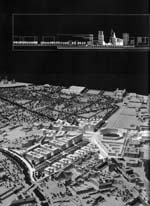


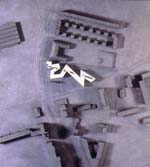

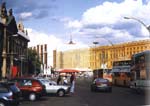
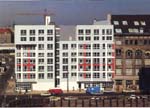

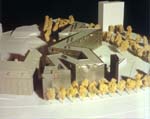

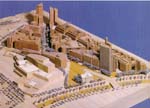
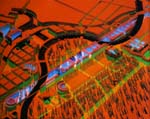
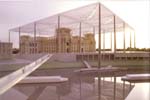
» back to top